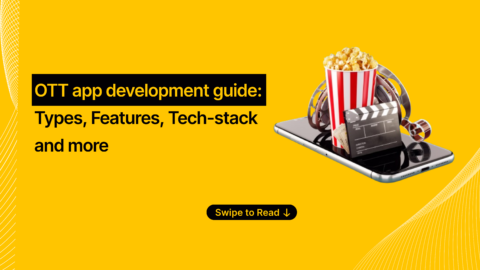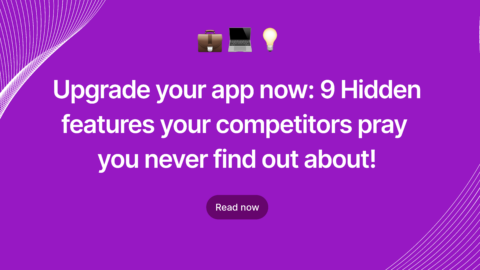Over time, users’ expectations for app performance have risen. Users nowadays hardly accept apps that do not meet their expectations. In fact, one out of every five users will uninstall an app after the first time they use it. One of the most prevalent reasons for this is poor design mistakes made in fitness apps.
It’s obvious that mobile app design matters, and it’s frequently the deciding factor in whether an app succeeds or fails. How can you ensure that your app is free of common design mistakes made in fitness apps? Let’s take a look at some of the greatest fitness app designs as well as some frequent blunders to see how to create a robust program while avoiding the pitfalls of mobile app design.
Top Mistakes Made In Fitness App UI Design
Several hundred screens can be found in a complicated program. Some of these screens are standard, such as sign-in or checkout displays, while others are tailored to a specific purpose. There are several fitness app design themes to choose from. You may utilize these to research current models and get ideas before coming up with your own.
Here are some of the top design mistakes made in fitness apps that you should avoid.
Home Screen
A fitness app’s home screen should display the user’s current activities as well as their progress toward a specified goal, such as losing weight or finishing a training course. Simple home pages should sum up the user’s experience with the service and encourage them to explore the app’s features.
Because most fitness applications include training and diet routines, their home screens provide simple progress charts. When app developers decide to make modifications, especially to a program with millions of registered users, they should start with the home screen. Even little changes may harm the user experience.
Also Read: 12 Best Healthcare Apps For Patients To Rule Healthcare Industry In 2022
Users were puzzled when MyFitnessPal redesigned the program in 2018 and featured blog entries instead of diary summaries on the top page. This case study illustrates how MyFitnessPal may return to displaying calorie intake and nutrients on the home screen, as well as a proposed redesign.
This is a very important feature. It’s a losing battle for businesses when anything distracts consumers as soon as they launch an app or when the information they need is concealed on a secondary screen.
The more features an app has, the more difficult it is to display them on a home screen. Take, for example, the period-tracking software Clue. Clue collects a wealth of information on reproductive health, however, the top page just displays a cycle with day markers. As a consequence, the software appears to be straightforward, user-friendly, and useful. Colors denote different stages of the cycle, and a large button in the middle encourages users to submit their current information.
Onboarding Screens
Almost every fitness app necessitates registration. Email and Facebook are the two most prevalent ways to do this. Following the creation of an account, most programs need users to go through a setup procedure and input personal attributes and preferences.
While it may appear to be a simple process, applications lose prospective consumers throughout the setup process. There are a few options for dealing with this. Another reason users exit an app is because it is too difficult to sign in.
Making it feasible for users to bypass onboarding and explore the app without having to enter a lot of personal information is a critical problem.
The nutritional app Lifesum makes a great step by asking users to choose a goal, which they may do by selecting one of three options: keep healthy, lose weight, or increase weight. It provides consumers the impression that the software would help them achieve their objectives. Furthermore, the design incorporates a sense of lightness into even the smallest details. While waiting for the next screen to load, users may enjoy an entertaining animation.
Freeletics employs the same strategies, requiring users to choose their top three goals right away. Freeletics, unlike Lifesum, does not include visual graphics or animations created expressly for an app. Instead, it features pre-recorded films of athletes performing the workouts.
Activity Tracking Screen
A separate screen should be allocated to fitness programs that measure user activity. This home screen has been redesigned multiple times due to one of the common UX mistakes made in fitness apps. The chart took up too much room in the original version, and it wasn’t apparent which colors corresponded to which heart rate zones and why. The colors were reorganized, and more information about the running session, such as average pace and distance, was included.
The first version of SmartRun’s home screen.
The final version of the activity screen.
Apple’s Activity app has a very practical design. Three activity rings, which refer to the three main goals, are the main focus on the screen. At the bottom of the page, users can view their activity details, at the top of it, users are shown the week or the month’s general statistics.
Fitness Plans Screen
There should be a screen with a variety of programs to pick from and follow, whether it’s a diet, fitness, or meditation app. There might be a variety of routines, each with a brief introduction and videos. Apps frequently offer premium plans, which are more customized, when this is a fundamental function. Assume a user has a workout generator that takes into account their fitness level, desired length, available equipment, and other factors.
For example, Freeletics provides a variety of free exercises as well as a paid coach service targeted to a specific user. Because the coach function is how Freeletics generates money, the app provides tailored programs directly on the main screen. It’s completely understandable, but for those who don’t want to pay for a membership, it may be upsetting.
Fitness plans in Freeletics. Source: apps.apple.com
SmartRun app also provides running plans. Here’s the screen:
Colors
To begin with, the color palette must be consistent. Choose one primary color that will be seen the most and many more colors to go with it. Colors that are carefully chosen not only improve the user experience but also increase brand awareness. Additionally, app designers must consider color-blind clients who have difficulty distinguishing between certain hues. It is one of the common design mistakes made in fitness apps.
Animations
When it comes to making the program understandable for users, animations are really helpful. People are more interested and use the app more frequently when it contains animated features and charts. On the activity screen, there’s a basic pulse animation. Another example that demonstrates the user’s performance over time is here.
Visual Design
Two of the most popular types of images for health and fitness applications are fun graphics and real-life pictures. It’s difficult to say which is superior, and the dividing line is likely due to the fact that each feature appeals to various audiences. If the app is for training, athletes’ images will most likely be used in the backdrop. Every single fitness app design on this Behance collection features a human body on its displays.
Headspace uses empathetic cartoon characters to highlight their point, whilst Calm uses gorgeous scenery. You may get ideas for fitness app design from their examples.
The visual design of Headspace. Source:headspace.com
UX Design
While the UI of an app should entice consumers, UX design is what ensures user retention and popularity. It can damage the user experience if the software takes too many actions from the user, such as when there are too many buttons or their size is not ideal for finger contact.
One of the main guidelines is that a user should only be focused on one feature at a time. When numerous functions are available, they should be displayed on multiple, readily swipeable displays.
It’s also crucial to take into account a range of mobile devices. When an app is launched for both Android and iOS, the two versions should appear and feel similar. Different gadgets necessitate size optimization, which is a big issue for designers. Another consideration is slow internet response. Your application may need to load information offline or over a slow connection. You should consider this also as UX mistakes made in fitness apps that you should avoid.
Navigation
Users should be able to get to the things they want with minimal effort. Apps with cluttered displays and inconspicuous buttons are doomed to fail. If a tab bar has more than three buttons, for example, it is too difficult to navigate. Consumers will quickly hunt for better options if there is no progressive disclosure and users must browse endlessly instead of opening only the icons they are interested in.
It’s best to include input masks and a clever auto-complete mechanism when a user fills out forms. The keyboard should be automatically modified to a number pad for fields that need numerical input.
Also Read: Best UX Practices for Every eCommerce Site
Checkout procedures reveal several design mistakes made in fitness apps as well as proven beneficial selections. In most cases, a person fills out numerous fields of information, and if everything is displayed on a single screen, it’s tough to finish the form quickly. The goal is to break down an operation into manageable chunks and dynamically check field inputs.
Another item to think about is how the ‘back’ option is handled; sending a user back to the home screen every time they click ‘back’ is inconvenient. There may also be some unpredictability in terms of word use. Consider the case of verifying a cancellation. The possibility for employing ambiguous phrases, such as ‘cancel’ and ‘confirm,’ where ‘cancel’ indicates canceling the cancellation itself rather than the action, needs to be considered.
Notifications
People must be motivated to keep doing whatever they are doing to attain their fitness objectives by receiving push alerts. It’s difficult to strike the right balance here. You just want to send out a small number of push alerts. If there are too many, consumers will exit the app; in fact, this is one of the most common reasons for users to abandon a program. On the other side, too few or no alerts may cause users to forget about the app altogether.
The nature of fitness applications lends itself to positive and motivating alerts. People want to improve, and sending positive words won’t harm. Applications can go to such lengths to establish a motivating community that they provide updates on friends’ activities. Many fitness monitoring applications have a competitive element that allows users to compare outcomes, but this does not always imply that alerts about other people’s progress are relevant to them. For example, there have been concerns regarding similar features in Strava.
Privacy Issues
When an app asks for permissions, it should be clear to a user why that is needed and what information is shared. The intervention of privacy is a big concern among fitness app users, any app has to assure users it’s not tracking their user data without permission.
Introducing Changes in Fitness App Design
It’s possible that an app should be redesigned at some time. However, redesigns should be based on customer feedback, and only the aspects that users dislike should be changed. However, it can cause problems; the MyFitnessPal scenario is proof of that. No matter how good a fitness app idea is, if it doesn’t deliver what consumers anticipate, it will fail to acquire traction.
Some social networking app examples demonstrate how difficult it may be for users to adjust to even minor changes, such as a Twitter symbol changeover. Because millions of people use fitness monitoring apps as part of their daily routines, modifications should only be made as a consequence of user feedback.
In-App Purchases and Subscriptions
Consider how you’ll market a paid fitness service in the free version of your app if you wish to offer one. The benefits of premium memberships should be evident to users, and the product should pique their interest. For example, Lifesum displays food ratings for each meal, but only premium users have access to information about the scientific meaning of these ratings. To pique people’s curiosity, the app asks whether they want to learn more about nutritional values, which encourages them to do so.
You don’t want to annoy users by informing them about the premium version at random. Instead, the activities of the user should correlate to an item you intend to sell or a paid membership plan offer. When a person completes a basic training plan, for example, an app can deliver encouraging alerts. When it comes to how purchases are displayed, every detail counts. The color of a ‘purchase now’ button, for example, might elicit a sense of urgency.
Consistency
Create a useful and distinguishing design for your fitness app to make it powerful. During each iteration, test it on end-users to ensure that every functionality is shown in a user-friendly manner. Your application’s design should be consistent across all visual components, like buttons and typography, and interactive features, such as animations. Take inspiration from the greatest fitness app themes, but develop your own design.
To begin developing an app, you must first determine who your target customer is and what problems your service will address. You can create a persona, an empathy map, or a user flowchart, or utilize other methods to figure out who the end-user is. Only after conducting market research, studying the greatest fitness app designs, and interviewing users will you be able to completely comprehend which features an app need, how to prioritize them, and show them across numerous platforms.
Now you know the top design mistakes made in fitness apps that you should avoid. If you have an original fitness app concept, Please contact us and our app developers are pleased to talk about the design and development of your project with you.










